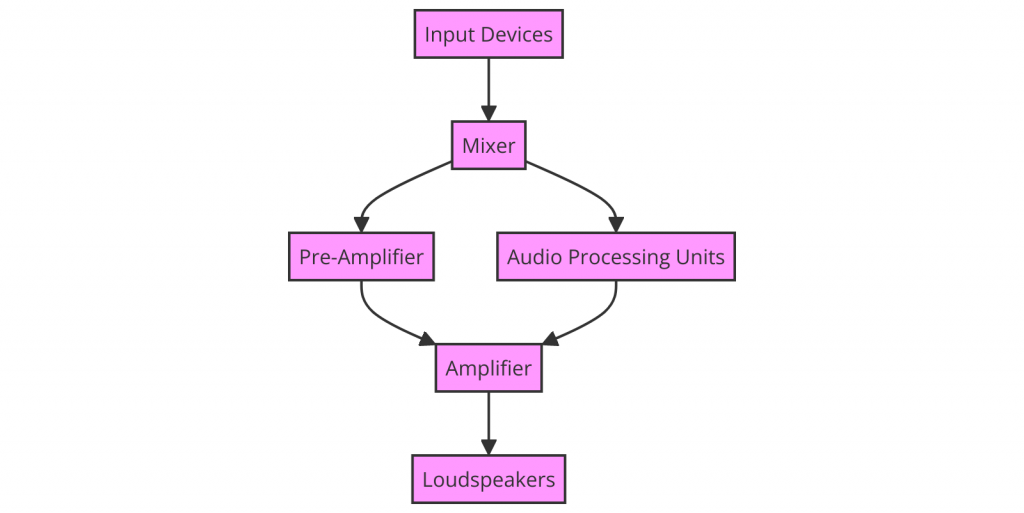Public Address (PA) systems are essential in a variety of settings, ranging from simple setups for small venues to complex configurations for large stadiums and public spaces. These systems enable the amplification of sound so that it can be heard clearly over a wide area, making them indispensable for events, announcements, and emergency communications. This article delves into the intricacies of PA systems, including their components, block diagram, and the essential requirements for an effective system.
Understanding the Public Address System
A Public Address System is an electronic amplification system used to reinforce a sound source, such as recorded music, a person speaking, or a video presentation, and distribute the sound throughout a venue or building. The system comprises several components that work together to capture, amplify, and deliver sound.
Block Diagram of a PA System
The block diagram of a PA system illustrates the flow of signal from the input to the output, highlighting the essential components involved in the process:

- Input Devices: The first stage involves input devices like microphones or line inputs from audio playback devices. These devices capture the sound and convert it into an electrical signal.
- Mixer: The mixer is a crucial component that allows the adjustment of volume, tone, and dynamics of the audio signals from various inputs. It can blend multiple sources into a single, cohesive output.
- Pre-Amplifier: After mixing, the signal often passes through a pre-amplifier, which prepares the low-level audio signal for amplification by boosting it to a level that can be processed by the power amplifier.
- Amplifier: The amplifier significantly increases the power of the audio signal, enabling it to drive the loudspeakers effectively.
- Loudspeakers: Loudspeakers convert the amplified electrical signal back into sound waves, making the audio audible to listeners. The selection and placement of loudspeakers are critical for achieving clear sound coverage across the intended area.
- Audio Processing Units: This includes equalizers, compressors, and limiters that refine the audio signal, enhancing sound quality and preventing damage to the system components.
Components & Requirements of PA System
The efficiency and effectiveness of a Paging System depend on its components and their configuration:
- Microphones: The choice of microphone affects the quality of sound capture. Different types are used depending on the application, such as dynamic, condenser, and wireless microphones.
- Mixers: Mixers range from simple units with a few channels to complex consoles with the capability to mix dozens of inputs. They provide control over levels, panning, and effects.
- Amplifiers: The amplifier’s power rating should match the system’s requirements, ensuring it can deliver sufficient volume without distortion.
- Speakers: Speaker selection and placement are vital for achieving uniform sound distribution. Options include point source, line array, and ceiling speakers for different venues and applications.
- Cabling and Connectivity: High-quality cables and connectors are essential for reliable signal transmission between components.
- Power Supply: A stable and sufficient power supply is crucial for the system’s performance and longevity.
Essential Requirements for an Effective PA System
For a PA system to serve its purpose effectively, it must meet several key criteria:
- Clarity and Intelligibility: The system should produce clear and intelligible sound, ensuring that the audience can understand spoken words and appreciate musical nuances.
- Even Coverage: Sound should be evenly distributed, avoiding areas with too little or too much volume.
- Adequate Volume: The system must be capable of providing enough volume to reach the entire audience, overcoming ambient noise while avoiding excessive loudness that could lead to discomfort or hearing damage.
- Reliability: System components should be durable and reliable, minimizing the risk of failure during use.
- User-Friendliness: Operators should find the system easy to use, with intuitive controls and interfaces.
- Flexibility and Scalability: The system should be adaptable to different events and venues and scalable to accommodate growth or changes in requirements.
- Integration Capability: Ideally, the PA system should integrate seamlessly with other systems, such as video projection or lighting controls, enhancing the overall experience.
By carefully considering these aspects, one can design and implement a PA system that meets the specific needs of any venue or event, ensuring clear communication and enhancing the auditory experience for all involved.



